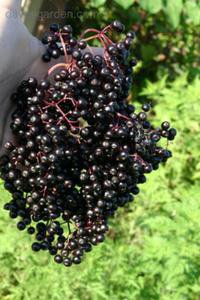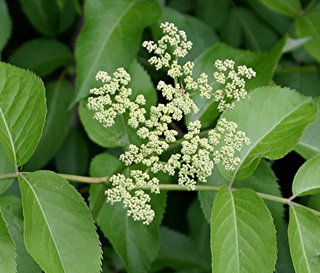





Many roadside plants had a number of important purposes in earlier times, whether they provide food, medicine or materials for clothing or dye-stuffs, it is interesting to step back into time and see what our ancestors used in everyday life.
Sambucus nigra is the common elderberry. It is native to Europe and its close relation Sambucus canadensis is its North American counterpart. These are large shrubs that love sunny meadows, fencerows and the edges around wooded areas and have long been a resource for people living off the land. It can grow up to 20' tall (6m) in optimum conditions and is hardy throughout a wide range of climate regions in Europe and North America.
 This plant has been used medicinally for centuries and is scientifically documented to help a number of conditions. One of the most frequent uses is for the treatment of chest congestion and colds. There are even commercially available elderberry products such as cough drops and syrups on the market in Canada and Europe. They can also be found in the US, but are not as mainstream. Elderberry extract has also been documented as having antiviral properties and tests are underway to determine how effective it is in treating anything from H1N1 flu to AIDS.
This plant has been used medicinally for centuries and is scientifically documented to help a number of conditions. One of the most frequent uses is for the treatment of chest congestion and colds. There are even commercially available elderberry products such as cough drops and syrups on the market in Canada and Europe. They can also be found in the US, but are not as mainstream. Elderberry extract has also been documented as having antiviral properties and tests are underway to determine how effective it is in treating anything from H1N1 flu to AIDS.
People planning to use elderberries medicinally, should note that the raw fruits contain cyanoglycoside sambunigrin and can cause nausea and intestinal distress if ingested before cooking. The good news is, all of the important properties in the raw fruits are not degraded when heated. A tasty cough syrup can be made by boiling a cup of the berries (separated from the stems and washed) with 3 cups of water, a couple cinnamon sticks, a few cloves and a few thin slices of ginger. Bring this to a boil and simmer for about 30 minutes. Strain the liquid through cheesecloth and once it is cool, add a cup of honey. Store it in the refrigerator and use about a teaspoon at a time for dosage. This syrup is also high in Vitamins C, A and B6. Another added plus is that the dark fruits contain high amounts of antioxidants...even more than blueberries! Just remember that natural remedies are only useful for minor ailments and professional medical treatment is advised for anything serious. Another interesting use for elderberries is that the crushed leaves make an effective insect repellent, which might be good information for hikers, however the scent is pretty strong and could be an effective repellent for human companions as well.
 Elderberries are excellent plants for wildlife gardens too. Many birds and small mammals love the berries and it is a host plant for a number of butterflies and moths, most notably the Cecropia moth, North America's largest moth. These plants spread by stolons near the ground and by seeds, so keep the underlying area clear to avoid a weedy appearance. The large, while umbrella-shaped flowers that bloom in late spring are a good source of nectar for pollinators and hummingbirds and are an excellent focal point in the landscape. The flowers can be battered and fried like a fritter for a tasty treat and a champagne-like drink (with very little alcohol content) can be made from the fermented blossoms.
Elderberries are excellent plants for wildlife gardens too. Many birds and small mammals love the berries and it is a host plant for a number of butterflies and moths, most notably the Cecropia moth, North America's largest moth. These plants spread by stolons near the ground and by seeds, so keep the underlying area clear to avoid a weedy appearance. The large, while umbrella-shaped flowers that bloom in late spring are a good source of nectar for pollinators and hummingbirds and are an excellent focal point in the landscape. The flowers can be battered and fried like a fritter for a tasty treat and a champagne-like drink (with very little alcohol content) can be made from the fermented blossoms.
Fruits ripen in late summer and the large masses of dark purple berries are attractive even if you don't use them, however, they are often used to make wines and depending on the mordant used, make a natural dye with colors ranging from olive green to black.
For an interesting addition to the healing or wildlife garden, the elderberry is an excellent choice and is also a wonderful landscape plant. There are even a number of commercial cultivars available, so there should be good options for most gardens and situations.
Copyright © www.100flowers.win Botanic Garden All Rights Reserved